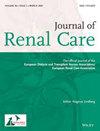Frequent blood glucose tests are performed for people with diabetes receiving haemodialysis.
To determine the rate of out-of-range post-haemodialysis blood glucose levels that are clinically acted upon, the intervention and outcome of each intervention, and the associations between post-haemodialysis blood glucose levels and relevant clinical predictors.
12-month retrospective cohort medical record review in one Australian haemodialysis centre. Post-haemodialysis blood glucose levels, prehaemodialysis blood glucose levels, time of treatment, diabetes medications, intradialytic fluid removal, dialysate dextrose concentration, clinical actions, interventions, and outcomes on out-of-range blood glucose levels were retrieved.
22 participants with a median time receiving dialysis 3.1 years (interquartile range 2.3−4.7).
The proportion of out-of-range post-haemodialysis blood glucose levels was 87.3% (95% confidence interval, 86.1%−88.5%). No out-of-range post-haemodialysis blood glucose levels were clinically acted upon. Out-of-range post-haemodialysis blood glucose levels were 4.6 times more likely if a higher dextrose bath was used (95% confidence interval: 3.3; 6.3. p < 0.001). The odds of the post-haemodialysis blood glucose levels increased by each 1 mmol/L. Intradialytic fluid removal, dialysate dextrose concentration, sex, dialysis time, anti-hyperglycaemic agents were also associated with out-of-range post-haemodialysis blood glucose levels.
Routine post-haemodialysis blood glucose levels testing has limited clinical utility in care for people with diabetes receiving maintenance haemodialysis. Higher dextrose dialysate may require individual titration depending on prehaemodialysis blood glucose levels.


